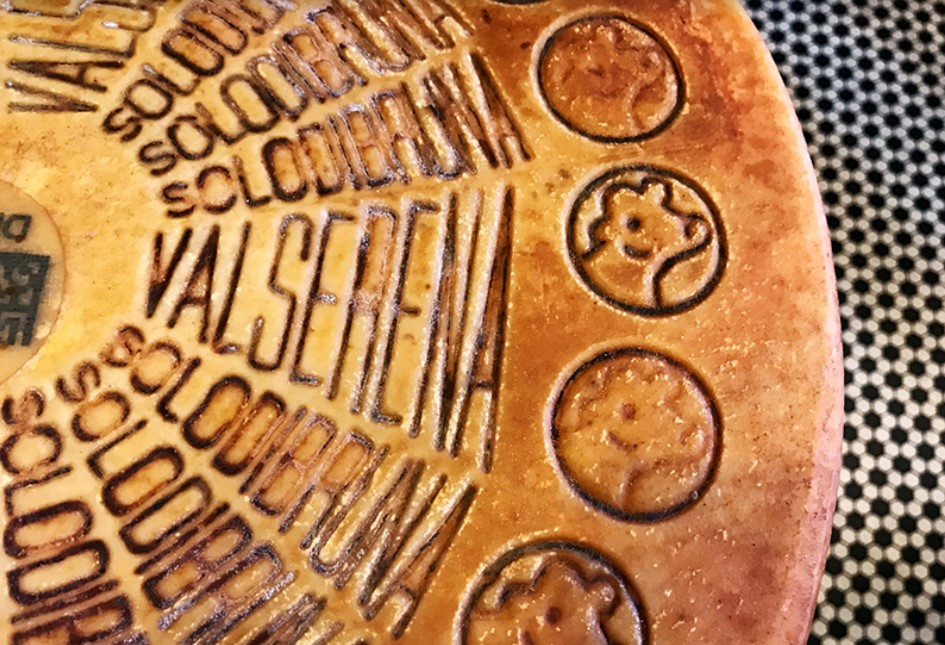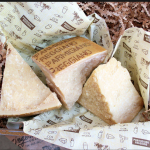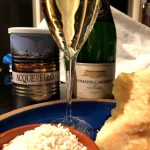Excerpt from Ari’s Top 5 enews
Farmstead Parmigiano Reggiano from a 5th-generation family-run dairy,
made from the milk of Sola Bruna cows
 Back in 1982 when we opened, it was hard to get our hands on Parmigiano Reggiano. Today, by contrast, you can probably find the classic “parmesan” of Italy in nearly every upscale grocery in the U.S. While that’s good news for food lovers, there’s more to the story. Unbeknownst to most consumers, there are nearly 400 dairies that each make their own, slightly different, Consorzio-approved version of Parmigiano Reggiano. In the way that not all Pinot Noirs are the same, so too are there big differences between one maker of Parmigiano Reggiano and another. And while all of the wheels that bear that name are good, a few are particularly special. If you’ve never tried the cheese from Valserena, you’re in for a treat.
Back in 1982 when we opened, it was hard to get our hands on Parmigiano Reggiano. Today, by contrast, you can probably find the classic “parmesan” of Italy in nearly every upscale grocery in the U.S. While that’s good news for food lovers, there’s more to the story. Unbeknownst to most consumers, there are nearly 400 dairies that each make their own, slightly different, Consorzio-approved version of Parmigiano Reggiano. In the way that not all Pinot Noirs are the same, so too are there big differences between one maker of Parmigiano Reggiano and another. And while all of the wheels that bear that name are good, a few are particularly special. If you’ve never tried the cheese from Valserena, you’re in for a treat.
Located in the lowlands of the Po River Valley, the caseificio at Valserena is the oldest Parmigiano dairy in the Parma district. It’s one of the few farmstead Parmigiano Reggiano cheeses still made—all the milk comes exclusively from the Serra family’s own herd. They raise the animals, grow the feed, milk the animals, and make the cheese right on the farm. Of particular note is the fact that their herd is made up exclusively of the rare and very special Sola Bruna (Brown) cows. This old breed, of Swiss origin, was introduced into Italy in the 16th century. The Serra family started to bring them to their land in 1879. Today they account for less than half of 1-percent of Italy’s dairy cows, and Valserena is one of only four dairies who make cheese solely from Sola Bruna milk. The Sola Bruna are beautiful animals, known for producing smaller quantities of milk, but the milk they give is particularly rich in butter fat—known for making excellent cheese. Giovanni Serra and his sister Antoinetta take enormous care for each cow. Excessive amounts of fear aren’t healthy for animals either. At Valserena, the cows are treated with dignity every day—the quality of the feed is exceptional, the barns are airy and clean, and Antonietta will happily recite each of their names if you ask. All of which manifests in the form of better milk quality.
The wheels of Valserena that we have on hand right now are a wonderful 36 months of age. Because it’s so good, the Valserena cheese is great on its own. Put pieces out with drinks before dinner. It’s one of the best things I know to do with Parmigiano Reggiano—talk, nibble, sip some wine, and appreciate the elegance and craft of what you’re eating. I’ll remind you (and myself as well) that Parmigiano Reggiano is really at its best when it’s broken into small uneven nuggets—not cut with a knife into straight-sided cubes. The rough edges add to the richness and complexity of the eating experience. The Valserena Parmigiano Reggiano is delicious with great varietal honey (especially for me, Chestnut), Red Walnuts, and also with a few of those amazing dates from Rancho Meladuco. Read more on how to build the perfect cheese board here!
You can cook with the Valserena cheese too. I grate it onto vegetable soups, salads (I love it on a simple green salad), or pasta. It’s particularly good with pasta made with soft butter and basil, a dish I like to make with short, squat pasta. It needs to be something really great since the dish is so simple. Mezze Maniche, or “short sleeves,” from the farmstead production of Mancini are a favorite at our house (we use their maccheroni at the Roadhouse for the Mac & Cheese). The Primo Grano penne from Rustichella, or the Vesuvio (looks like swirls of smoke emerging from the top of Mount Vesuvius) from the fine folks at Gentile would work well too. (If you want to drive past Mt. Vesuvius in person, consider coming with us on this fall’s Zingerman’s Food Tours’ terrific week-long food and wine extravaganza to Sicily.)




